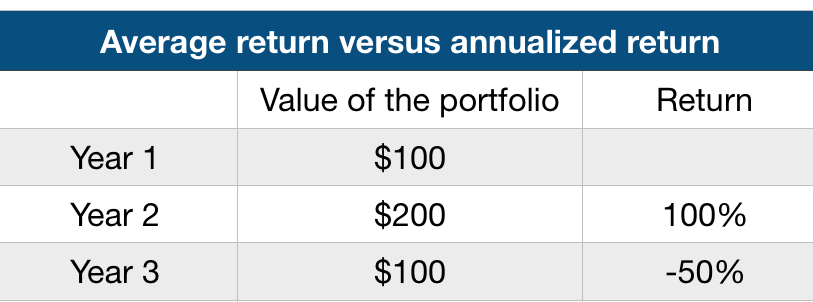Annualized returns
Introduction to Portfolio Analysis in Python

Charlotte Werger
Data Scientist
Comparing returns
Annual Return: Total return earned over a period of one calendar year
Annualized return: Yearly rate of return inferred from any time period
Average Return: Total return realized over a longer period, spread out evenly over the (shorter) periods.
Cumulative (compounding) return: A return that includes the compounded results of re-investing interest, dividends, and capital gains.
Why annualize returns?
$$

$$
- Average return = (100 - 50) / 2 = 25%
- Actual return = 0% so average return is not a good measure for performance!
- How to compare portfolios with different time lengths?
- How to account for compounding effects over time?
Calculating annualized returns
$$
N in years: $rate= (1 +Return)^{1/N} -1$
N in months: $rate= (1+Return)^{12/N} -1$
Convert any time length to an annual rate:
- Return is the total return you want to annualize.
- N is number of periods so far.
Annualized returns in python
# Check the start and end of timeseries
apple_price.head(1)
date
2015-01-06 105.05
Name: AAPL, dtype: float64
apple_price.tail(1)
date
2018-03-29 99.75
Name: AAPL, dtype: float64
# Assign the number of months
months = 38
Annualized returns in python
# Calculate the total return
total_return = (apple_price[-1] - apple_price[0]) /
apple_price[0]
print (total_return)
0.5397420653068692
Annualized returns in python
# Calculate the annualized returns over months
annualized_return=((1 + total_return)**(12/months))-1
print (annualized_return)
0.14602501482708763
# Select three year period
apple_price = apple_price.loc['2015-01-01':'2017-12-31']
apple_price.tail(3)
date
2017-12-27 170.60
2017-12-28 171.08
2017-12-29 169.23
Name: AAPL, dtype: float64
Annualized return in Python
# Calculate annualized return over 3 years
annualized_return = ((1 + total_return)**(1/3))-1
print (annualized_return)
0.1567672968419047
Let's practice!
Introduction to Portfolio Analysis in Python

